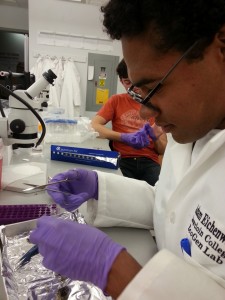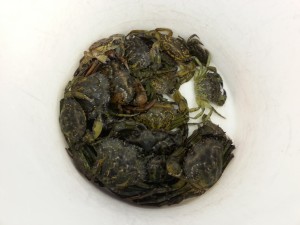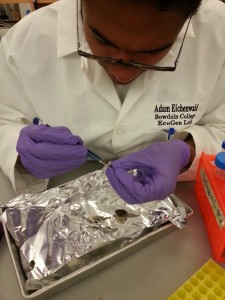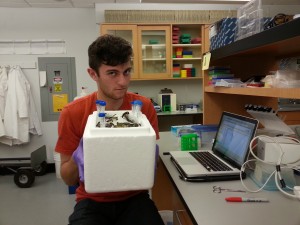Last week I travelled with Dr. Sarah Kingston (Doherty Marine Biology Postdoctoral Scholar), Dr. Dave Carlon (Director of the Coastal Studies Center), and Marko Melendy (Animal Care Supervisor) to collect mussels at two sites here in Maine: Hurricane Island and Mt Desert Rock. We collected blue mussels (Mytiulus edulis) and bay mussels (M. trossulus) for an experiment Sarah is conducting. She is examining the genetic basis of variation in shell calcification under environmental conditions possible due to ocean acidification. In this round of experiments (the first round was conducted to determine which experimental scheme yielded the greatest variation in shell calcification), there will be one control tank (some food, ambient temperature, and ambient pH) and three identical experimental tanks (no food, high temperature, and low pH). After two weeks, the mussels will be removed from the tanks, their change in shell calcification recorded, and samples of the mussels’ muscles collected. The DNA in these tissue samples will analyzed by a technique called next generation sequencing, and Sarah will look for genetic variation that is associated with calcification rates.
Our trip began at eight on Tuesday morning (August 12, 2014), when we drove to Rockland and then boarded a boat that took us to Hurricane Island. 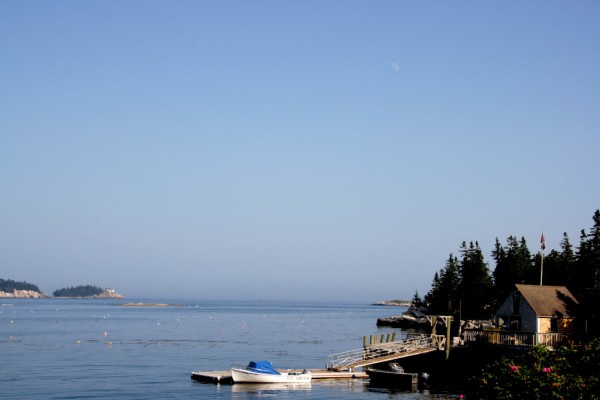 By the standards of places that are off the power grid, Hurricane Island is luxurious. They have an impressive solar array that enables hot showers, phone and computer charging, and electric lighting. Hurricane Island was also surprisingly busy; in addition to our little group and the people who work on the island, there was a high school group and some wilderness-first-responders-in-training. Once we arrived on the island, we dropped our things off and hopped back on the boat. Mussels live in the intertidal zone, and it’s easiest to collect them at low tide. Sarah had already asked around for likely sites, which we approached by boat. We hopped ashore and began our search, looking under rockweed and in crevices beneath and between boulders. Our first several sites were rich with periwinkles, whelks, and barnacles, but the only mussels to be found were some solitary horse mussels (M. modiolus). This was what we had feared might happen. When asked where to find mussels, people commonly told Sarah to try such-and-such place, but that there weren’t as many as there used to be. At least the day was beautiful. I’m from Hawaii, and let me tell you, there’s nothing more scenic than Maine in the summer time.
By the standards of places that are off the power grid, Hurricane Island is luxurious. They have an impressive solar array that enables hot showers, phone and computer charging, and electric lighting. Hurricane Island was also surprisingly busy; in addition to our little group and the people who work on the island, there was a high school group and some wilderness-first-responders-in-training. Once we arrived on the island, we dropped our things off and hopped back on the boat. Mussels live in the intertidal zone, and it’s easiest to collect them at low tide. Sarah had already asked around for likely sites, which we approached by boat. We hopped ashore and began our search, looking under rockweed and in crevices beneath and between boulders. Our first several sites were rich with periwinkles, whelks, and barnacles, but the only mussels to be found were some solitary horse mussels (M. modiolus). This was what we had feared might happen. When asked where to find mussels, people commonly told Sarah to try such-and-such place, but that there weren’t as many as there used to be. At least the day was beautiful. I’m from Hawaii, and let me tell you, there’s nothing more scenic than Maine in the summer time.
 As we cruised around, we decided on a whim to check an old pier for mussels growing on its sides. Finally we found them hiding in a generous crack just above the water level. With a certain amount of stretching and the help of the boat’s gaff, we were able to collect our first mussel specimens. However, we didn’t want just any mussels. They had to be two to three inches long. Recall that Sarah is interesting in calcification rate; mussels within this size range should still be adding to their shells because they’re in a growth phase. We collected approximately twenty appropriately-sized mussels, put them in a mesh bag, and placed them in a cooler with seawater and ice packs to keep them comfortable. Our luck held at our last two sites. The mussels in those places were not attached to rock as we expected—they were partially buried in the sand like clams. “The cool new lifestyle,” as Marko put it.
As we cruised around, we decided on a whim to check an old pier for mussels growing on its sides. Finally we found them hiding in a generous crack just above the water level. With a certain amount of stretching and the help of the boat’s gaff, we were able to collect our first mussel specimens. However, we didn’t want just any mussels. They had to be two to three inches long. Recall that Sarah is interesting in calcification rate; mussels within this size range should still be adding to their shells because they’re in a growth phase. We collected approximately twenty appropriately-sized mussels, put them in a mesh bag, and placed them in a cooler with seawater and ice packs to keep them comfortable. Our luck held at our last two sites. The mussels in those places were not attached to rock as we expected—they were partially buried in the sand like clams. “The cool new lifestyle,” as Marko put it.
 With about seventy mussels in hand, we returned to Hurricane Island. It was only around three in the afternoon, and we had the rest of the day to walk around the island, read, or nap.
With about seventy mussels in hand, we returned to Hurricane Island. It was only around three in the afternoon, and we had the rest of the day to walk around the island, read, or nap.
Wednesday morning was foggy, but that’s to be expected on the water at five in the morning. We took the boat back to the mainland and separated into two groups. Dave and Marko returned to Brunswick with the mussels we had collected. Sarah and I continued northward to Bar Harbor. From there, we departed for Mt Desert Rock. The fog followed us on our boat ride to the rock.
 Mt. Desert Rock is exactly what it says on the tin. It’s a six hundred by two hundred yard chunk of granite that protrudes from the sea.
Mt. Desert Rock is exactly what it says on the tin. It’s a six hundred by two hundred yard chunk of granite that protrudes from the sea.
It’s about twenty-six miles from shore and, like Hurricane Island, is completely off the grid. A lighthouse—built in 1847 using stone quarried on Mt. Desert Rock itself—stands next to the small house that housed the lighthouse keeper in the days of lighthouse keepers.  There is no running water on the rock. Drinking water is brought by boat along with other groceries. The coast guard has a solar array for the lighthouse, but power for the island’s crew is provided by their own small solar array and a backup generator. Non-electric lighting is provided by lamps that burn propane with kerosene. It’s bare of trees, which makes it look bleak, but it’s far from barren. There are grasses, wild rose bushes, and droves of sea gulls. Herring gulls (common gulls) and black-backed gulls (larger and more aggressive) share the island, and it’s almost impossible to walk five feet without getting screamed at by at least one. Juveniles are everywhere, some of them already flying and some still downy and small.
There is no running water on the rock. Drinking water is brought by boat along with other groceries. The coast guard has a solar array for the lighthouse, but power for the island’s crew is provided by their own small solar array and a backup generator. Non-electric lighting is provided by lamps that burn propane with kerosene. It’s bare of trees, which makes it look bleak, but it’s far from barren. There are grasses, wild rose bushes, and droves of sea gulls. Herring gulls (common gulls) and black-backed gulls (larger and more aggressive) share the island, and it’s almost impossible to walk five feet without getting screamed at by at least one. Juveniles are everywhere, some of them already flying and some still downy and small. 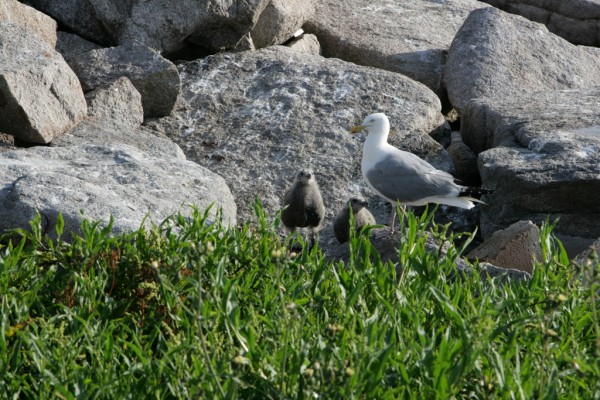 More exotic than the gulls, however, were the seals. Gray seals and harbor seals haul themselves out from the water onto the island every day. The island’s crew counts them daily, and counts of several hundred have been recorded. Our group was large for Mt. Desert Rock—the island’s crew, Sarah and me, and a group of fifteen high school students and their two counselors—so more seals than usual opted to remain in the water instead of facing the human horde. The seals that hauled out slept in the sun.
More exotic than the gulls, however, were the seals. Gray seals and harbor seals haul themselves out from the water onto the island every day. The island’s crew counts them daily, and counts of several hundred have been recorded. Our group was large for Mt. Desert Rock—the island’s crew, Sarah and me, and a group of fifteen high school students and their two counselors—so more seals than usual opted to remain in the water instead of facing the human horde. The seals that hauled out slept in the sun.
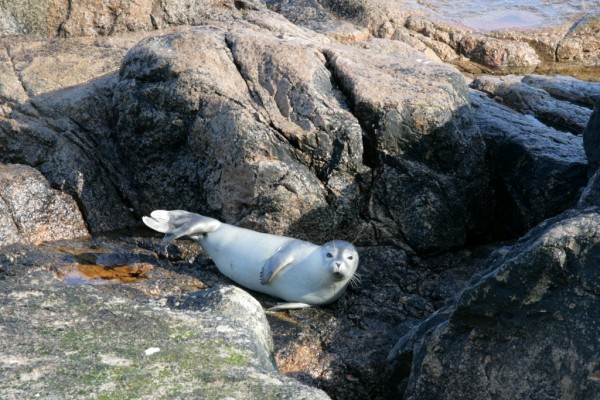
The wary seals floated offshore with their heads and necks out, looking like solemn mermaids.
We arrived on the island in the afternoon, with the high tide. Collection took place at low tide the next day, around two in the afternoon. The mussels on the rock were difficult to find. We were warned they would be small, but I didn’t process that until we were out looking for them. The first ones we found were nestled in among the barnacles; some had even grown in the shells of dead barnacles. These mussels were small enough to balance on the tip of my finger. I think the constant wave action may be responsible for their small size. We collected twenty or so of these tiny mussels, but we also found some larger ones—exceeding an inch in length—in the cracks in the rock.
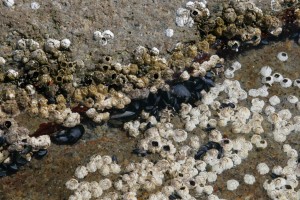 An hour and a half later we had collected approximately fifty specimens, and the rest of the day was free to spend watching the gulls, seals, and sea. I didn’t see any whales while I was on the rock, but we had seen porpoises on the boat ride out to the island. I was told by one of the crew members that minke whales can sometimes be seen from the rock—this testimony was supported by the sad, surprisingly small skull that was all that remained of a minke that had been beached on the island several years ago. When we left on Friday morning, there was a basking shark hanging out near the island. It wasn’t much to see—just a black fin—but knowing it was there was exciting. By Friday night we were back on Bowdoin’s campus.
An hour and a half later we had collected approximately fifty specimens, and the rest of the day was free to spend watching the gulls, seals, and sea. I didn’t see any whales while I was on the rock, but we had seen porpoises on the boat ride out to the island. I was told by one of the crew members that minke whales can sometimes be seen from the rock—this testimony was supported by the sad, surprisingly small skull that was all that remained of a minke that had been beached on the island several years ago. When we left on Friday morning, there was a basking shark hanging out near the island. It wasn’t much to see—just a black fin—but knowing it was there was exciting. By Friday night we were back on Bowdoin’s campus.
This is just the first step for the next phase of the project. This week we will travel even farther north to Cobscook Bay in pursuit of more mussels. When we have all our specimens, we will label each one and record its buoyant weight. They will be subjected to the ocean acidification manipulations for two weeks, after which they will be weighed again and dissected for muscle tissue samples. The DNA libraries will then be sent away for next generation sequencing, at which point Sarah can finally begin her true analysis.
Jenna Watling, ’16
Jenna has a faculty-student research fellowship working with Dave Carlon and Sarah Kinsgton on her project: “The evolutionary response of populations of the blue mussel (Mytilus edulis) populations to climate change”.
